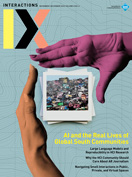Authors:
Anna Carter, Ceylan Beşevli, Christopher Dawes, Marianna Obrist
On one cold spring morning, as I walked down Oxford Street in London on my way to the office, there was so much sensory experience to absorb, such as the chilly tactile sensation of a spring morning and the glaring sunshine. The city was bustling into wakefulness with shops raising their screens. All this contributed to a vibrant sensory experience. After completing speculative futuring technology workshops for public spaces with children, where the students took a keen interest in multisensory technologies, particularly scent, my fascination with multisensory experiences in urban environments was significantly heightened. As I continued along to…
You must be a member of SIGCHI, a subscriber to ACM's Digital Library, or an interactions subscriber to read the full text of this article.
GET ACCESS
Join ACM SIGCHIIn addition to all of the professional benefits of being a SIGCHI member, members get full access to interactions online content and receive the print version of the magazine bimonthly.
Subscribe to the ACM Digital Library
Get access to all interactions content online and the entire archive of ACM publications dating back to 1954. (Please check with your institution to see if it already has a subscription.)
Subscribe to interactions
Get full access to interactions online content and receive the print version of the magazine bimonthly.






